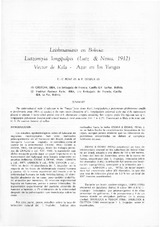Leishmaniasis en Bolivia : Lutzomyia longipalpis (Lutz & Neiva, 1912) Vector de Kala - azar en los Yungas
| dc.contributor.author | Le Pont, F | |
| dc.contributor.author | Desjeux, P | |
| dc.date.accessioned | 2019-02-18T16:15:11Z | |
| dc.date.available | 2019-02-18T16:15:11Z | |
| dc.date.issued | 1983 | |
| dc.identifier.uri | http://repositorio.umsa.bo/xmlui/handle/123456789/18870 | |
| dc.description.abstract | Summary. The epidemiological study of kala-azar in the "Yungas" focus shows that L. longipalpis, a predominant phlebotomine sandfly in peridomestic areas (96% of catches) is the main vector, Dissections of L. longipalpis performed at the end of the rainy season allowed to separate 5 stocks which proved close to L. donovani complex, considering their isozymic profile. The infection rate of L. longipalpis populations found around isolated houses, in rural areas, varies from 1 to 4.2%. Transmission is likely to be more active in the warmer bottoms of valleys. | es_ES |
| dc.language.iso | es | es_ES |
| dc.publisher | Instituto Boliviano de Biología de Altura | es_ES |
| dc.subject | LEISHMANIASIS | es_ES |
| dc.subject | BOLIVIA | es_ES |
| dc.subject | LUTZOMYIA LONGIPALPIS | es_ES |
| dc.subject | YUNGAS, BOLIVIA | es_ES |
| dc.title | Leishmaniasis en Bolivia : Lutzomyia longipalpis (Lutz & Neiva, 1912) Vector de Kala - azar en los Yungas | es_ES |
| dc.type | Article | es_ES |

